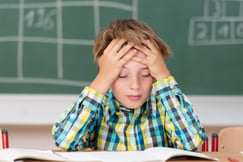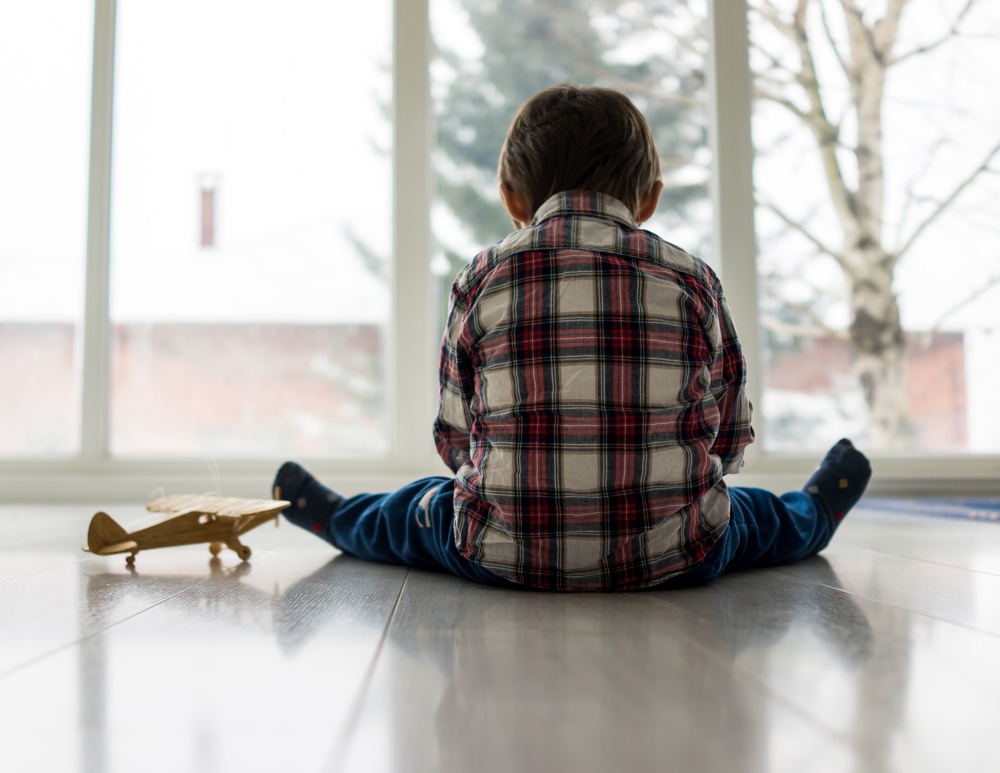5 Ways to Help Reduce Anxiety in Children with Autism

Download FREE Autism Behavior Intervention Technique
It’s likely that we all know someone who experiences anxiety, and there’s no doubt that anxiety can be exhausting and can interfere with daily life. For children with autism, anxiety can occur more frequently and can be very intense. Seemingly simple daily activities such as leaving the house, interacting with peers, riding in the car, or taking public transportation can become increasingly difficult and anxiety provoking. In order to help children who may be experiencing anxiety, it is important for parents and teachers to understand anxiety and how it may be affecting children with autism.
What are the links between autism and anxiety?
It is estimated that 18% of the entire population has some form of anxiety disorder.[1] There have been several studies that show varying results, but it is estimated that between 11% and 84% of people with autism also have an anxiety disorder.[2] It’s not exactly known why these studies have shown such a wide variety of results, but there is some knowledge as to why anxiety may occur in people with autism at a higher rate than for the general population.
Overlapping criteria. The characteristics of autism and anxiety can sometimes overlap. Often times, children who have autism and anxiety can display their anxieties through a variety of behaviors. These can include becoming over-stimulated, heavily dependent on schedules, self-injuring, outbursts of emotion, or becoming withdrawn. These behaviors are characteristics of both autism and anxiety, and when an individual has both, the anxiety symptoms can be intensified.
 Fear of how others are perceiving them. Some people with autism struggle with social skills such as eye contact, conversation, and reading body language or expressions. People with autism may develop anxiety because they fear that others may be criticizing them for their actions or struggles in social situations.[3] They may feel as though they need to monitor their own actions, which can lead to more anxiety within social interactions due to overthinking and overanalyzing their own actions.
Fear of how others are perceiving them. Some people with autism struggle with social skills such as eye contact, conversation, and reading body language or expressions. People with autism may develop anxiety because they fear that others may be criticizing them for their actions or struggles in social situations.[3] They may feel as though they need to monitor their own actions, which can lead to more anxiety within social interactions due to overthinking and overanalyzing their own actions.
Types of anxiety and what to look for
There are many different types of anxiety. While any form of anxiety can occur in someone with autism, according to the Indiana Resource Center for Autism at Indiana University Bloomington, the most likely to occur are specific phobia, obsessive compulsive disorder, and social anxiety.
Specific Phobia. Specific phobia occurs frequently in those who have autism. This type of anxiety is when a person has a fear of a certain object, place, or situation. For example, someone may be afraid of bees and avoids going outside in the summer, or someone may be afraid of toilets, cats, or amusement parks and avoid these places as well. Individuals with specific phobia will often avoid any situation where there is a chance they will encounter their fear, which leads to a very restricted lifestyle. In cases where the child has significant autism, caregivers should be aware of the environment when anxiety occurs. This can help pinpoint what is triggering the anxiety in children who may not be able to communicate their anxieties.
Obsessive Compulsive Disorder. Repetitive and obsessive behaviors often characterize this type of anxiety disorder. People with OCD will often feel that if they do not perform a certain activity repeatedly or a certain number of times, something negative will happen. This disorder can interfere with daily life in a number of ways, including obsessive thoughts and compulsive actions that can overtake their life.
 Social anxiety. Social anxiety is seen frequently in children who have autism. This may be because many people with autism struggle with social interactions, which can include eye contact, conversation, social cues, and body language. Social anxiety can present itself in a variety of ways, including avoiding social situations altogether, becoming shaky or sweaty during social situations, or having a racing heartbeat.
Social anxiety. Social anxiety is seen frequently in children who have autism. This may be because many people with autism struggle with social interactions, which can include eye contact, conversation, social cues, and body language. Social anxiety can present itself in a variety of ways, including avoiding social situations altogether, becoming shaky or sweaty during social situations, or having a racing heartbeat.
Five Ways to Help Your Child with Anxiety
- Pinpoint what triggers anxiety. Identifying what causes the child’s anxiety can be helpful in identifying ways to help them. If the anxiety trigger is known, you can help the child cope with and possibly overcome their fears. Parents and teachers may encourage the child to engage in situations that are anxiety provoking (but safe), and praise or reward the child when they do so.
- Visual Schedules and Transitions. Children with anxiety and autism often struggle to transition between activities at school and during daily life. The struggle to transition between activities can often be intensified if children are transitioning between a high-preference activity and an activity they do not enjoy. To help with this, many children can benefit from a visual schedule, which may include a picture of the activity and a time that the activity will occur. These schedules can help children know what to expect and in turn reduce anxiety levels. It may also be helpful to show the child a picture or video of transitioning smoothly to the next activity before doing so. The video or picture can provide a positive example of a smooth transition, but can also help the child know what is coming up next.
- Safe spaces. For children who have anxiety, providing a safe space for them when they are feeling anxious or overwhelmed can be helpful. However, it is important to keep in mind that a safe space should not be used as a regular solution to anxiety. Rather, it should be used only when needed during extreme situations. If a safe space is overused they could become a way to escape daily life and activities in fear of anxiety triggers, which is not the intention. Often, a child who is experiencing social anxiety at school will become overwhelmed while interacting with peers in group settings, walking down a busy hallway, or eating in a noisy lunchroom. If a child is experiencing extreme anxiety from these things, a teacher may create a safe space that can include beanbags, calming games such as some puzzles, stress balls, or relaxing music. Different things will relax different children, so it’s important to keep the child’s individual needs in mind while creating a safe space.
- Relaxation techniques. There’s a lot of recent research coming into schools about relaxation techniques such as meditation. Meditation has been shown to help many students reduce their anxiety levels, from test-taking anxiety to anxiety in daily life. However, meditation may not be the right fit for every student who is experiencing anxiety, which is important to keep in mind while searching for anxiety reducing techniques. Stages Learning has put together a helpful sheet on how to introduce and use meditation for children with autism.
- Social Narratives Social narratives can be a great way for teachers and parents to show children situations before they happen. A social story can be as simple as a story about walking to the cafeteria or going to a grocery store, but the story should model what events will likely occur during the situation. By reading the social story before the event happens, children may feel less anxious about what is going to happen. It’s also an option to create a social story that shows something anxiety provoking, and modeling a way to overcome this. By modeling this through a social story, children may be more likely to handle the situation in a calm manner. Stages Learning Language Builder Sequencing Cards help children navigate transitions by providing visual cues as to what is going to happen next such as washing hands, brushing teeth, or what is involved in going to the grocery store. Because children with autism are frequently visual learners it can help children understand a social story by providing a set of cards indicating next steps. Stages Learning has examples of Social Narratives that you can download and use.
[1] Anxiety and Depression Association of America, (2016). Available: https://www.adaa.org/about-adaa/press-room/facts-statistics.
[2] Dubin, A., Lieberman-Betz, R., & Michele Lease, A. (2015). Investigation of Individual Factors Associated with Anxiety in Youth with Autism Spectrum Disorders. Journal Of Autism & Developmental Disorders, 45(9).
[3] Merrill, Anna. (n.d) Anxiety and Autism Spectrum Disorders. Indiana University Bloomington, Indiana Resource Center for Autism.

Kasey Salvatore
Kasey Salvatore is currently an undergraduate student at Lesley University majoring in special education and global studies. Her passion for special education was initially sparked at an early age through experiences with friends and family. More specifically, her mother was a special education teacher and therefore Kasey was introduced to the field throughout her childhood. Additionally, she has experience with children who have special needs through student teaching, friendships and volunteer opportunities. She also currently cares for a 5-year-old boy who has autism and a rare genetic disorder. Kasey’s ultimate goal is to work with children who have autism in an educational or therapeutic setting. In her spare time, Kasey can be found writing, drawing or spending time with friends and family.





